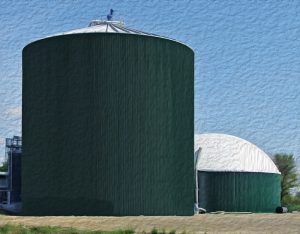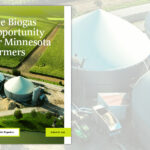Maureen Walsh
BioCycle January 2016
On October 23, 2015, the U.S. Environmental Protection Agency published its highly anticipated final rule implementing Carbon Pollution Emission Guidelines for Existing Electric Utility Generating Units, also known as the Clean Power Plan (CPP). The rule regulates emissions from fossil electric power plants. With the official publication, it’s now up to the states to formulate their compliance plans. Publication also allows the rule to be challenged in court.

The contribution that anaerobic digesters can make to reduce CO2 emissions while generating electricity paves the way for inclusion of these systems in each state’s Clean Power implementation plans.
The standards dictated by the plan demand modest improvements in the greenhouse gas (GHG) emissions performance of coal-fired electric generating units (EGUs). However, the real focus of the CPP is increased deployment of natural gas-fired and renewable generating capacity in the United States. Biogas systems can help reach the regulation’s goals since they can produce electricity with near zero emissions.
Structure And Timing
The CPP’s goal is to reduce carbon emissions from the existing national electricity sector by approximately 28 percent below 2005 levels by 2025, and by approximately 32 percent below 2005 levels by 2030. States need to develop plans to reach these standards. The CPP establishes standards of performance for CO2 emissions from existing fossil fuel-fired power plants, based on the EPA’s determination of the “best system of emission reduction” (BSER). These standards, applied to each state’s particular mix of fossil fuel-fired EGUs, generate the state’s carbon intensity goal for 2030 (and interim rates for the period 2022-2029).
Each state will determine whether to apply these to each affected EGU or to take an alternative approach to meet either an equivalent statewide rate-based goal or statewide mass-based goal. The EPA does not prescribe how a state must meet the emission guidelines, but, if a state chooses to take the path of meeting a state goal, these final guidelines identify the methods that a state can or, in some cases, must use to demonstrate that the combination of measures and standards that the state adopts meets its state-level CO2 goals.
Each state must submit either a final plan, or an initial plan with a request for an extension, to the EPA by September 6, 2016. An extension of up to two years (until September 6, 2018) to submit a final plan may be granted. However, should a state not submit an EPA-approvable plan, existing sources of emissions in the state will be subject to the requirements of a Federal Implementation Plan (FIP). The same day the CPP was released, the agency also issued a proposed rule with federal plan requirements (see below), which will form the basis of any FIP. For the anaerobic digestion industry, it is important that all biogas provisions possible are included in this FIP, which many states will likely use to comply with the CPP.
The CPP final rule gives states considerable flexibility with respect to the timeframes for plan development and implementation, as well as the choice of emission reduction measures. Up to 15 years are provided for full implementation of all emission reduction measures, with incremental steps for planning and then for demonstration of CO2 reductions to ensure progress is being made. It’s within this framework that the American Biogas Council (ABC) and its members need to work with the states that are developing their own implementation plan to make sure their plans are as favorable to biogas systems as possible. Implementation plans that include biogas systems as a tool will provide business and system deployment opportunities for anaerobic digestion and biogas power in those states.
Each state’s obligation to reduce GHG emissions is based on EPA’s determination as to what reductions can be accomplished in the state using the BSERs for EGUs. The EPA has determined that the BSERs comprise the first three (of a total of four) proposed “building blocks”: 1) Improving heat rate at affected coal-fired steam EGUs; 2) Substituting increased generation from lower-emitting existing natural gas combined cycle units for generation from higher emitting affected steam generating units; and 3) Substituting increased generation from new zero-emitting renewable energy generating capacity (biogas systems are not included but should be) for generation from affected fossil fuel-fired generating units.
Because of the limited reach of Section 111(d) of the Clean Air Act (under which EPA is administering the CPP), and a recent admonition from the Supreme Court that EPA not mine old statutes for new authority “to regulate ‘a significant portion of the American economy’” (see Utility Air Regulatory Group v. EPA, 134 S. Ct. 2427, 2444 (2014)), the “building blocks” in the final CPP are limited to measures that more or less directly affect emissions from fossil-fuel-fired EGUs.
“Biogas Power” In State Plans?
Anticipating questions about how biomass in its many forms could help, the EPA worked with its Science Advisory Board peer review panel. This panel agreed that use of biomass feedstocks derived from the decomposition of biogenic waste in landfills, composting facilities or anaerobic digesters did not constitute a net contribution of biogenic CO2 emissions to the atmosphere. This is great for biogas because it confirms the contribution biogas systems can make to reducing emissions — and is a major tool to use to get biogas systems included in each state’s implementation plan.
The EPA generally acknowledges the CO2 and climate policy benefits of waste-derived biogenic feedstocks and certain forest- and agriculture-derived industrial by-product feedstocks, based on conclusions supported by a variety of technical studies, including the revised Framework for Assessing Biogenic Carbon Dioxide for Stationary Sources.
Use of such waste-derived and certain industrial by-product biomass feedstocks in a system like an anaerobic digester, would likely be approvable as qualified biomass in a state plan as long as the state’s plan includes measures that meet the CPP’s biomass monitoring, reporting and verification requirements discussed in the rule and other measures as required elsewhere in the emission guidelines.
EPA estimates that, by 2030, approximately 28 percent of U.S. electricity will come from renewable generation. As such, the CPP rewards states that invest in renewable energy and demand-side energy efficiency in the short term — during 2020 and/or 2021 — through the Clean Energy Incentive Program (CEIP). Additional allowances or emissions credits will be available to states through CEIP in exchange for early investments in zero-emission generation and/or demand side energy efficiency projects. EPA intends for the CEIP to maintain a reserve for zero emissions (only wind and solar) projects and demand side energy efficiency projects in low income communities. The CEIP is a “matching fund” and, although participation is voluntary, it provides incentives for states to invest in new zero emissions generation projects and follow through on planned investments.
The EPA discusses the CEIP in the proposed federal plan rule and will address design and implementation details of the CEIP in a subsequent action. Prior to doing so, the EPA will engage with states, utilities and other stakeholders to gather information regarding their interests and priorities with regard to implementation of the CEIP. This is an opportunity to ask for biogas to also be included in this incentive program.
Federal Implementation Plan
As noted earlier, states that do not develop their own implementation plan will use the Federal Implementation Plan (FIP) by default. EPA issued the final CPP rule in tandem with proposed “federal plan requirements” for implementing the CPP. These requirements, which are limited to the three “building blocks” outlined above, serve two purposes. First, they provide states with a set of implementation strategies that are presumptively approvable if incorporated in a state plan. Second, they provide a preview of the federal implementation plan that EPA would impose on a state that fails to submit an approvable plan for CPP compliance.
Because the federal plan standards include only “building block” measures, a FIP would be more stringent and offer less flexibility than state plans that also include other reduction measures. It also would not include biogas since biogas is not included in the three building blocks. This approach is intended to provide a strong incentive for states to submit approvable plans, so the entire burden of compliance does not fall on their affected EGUs. The American Biogas Council is working to ensure biogas is included in the federal implementation plan to catch the remaining states.
Maureen Walsh is the founder of Dynamic Change Group, LLC, a government affairs consulting firm focused on clean energy and environmental technologies. She has represented the American Biogas Council since 2011.













